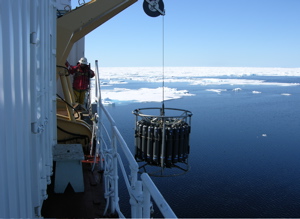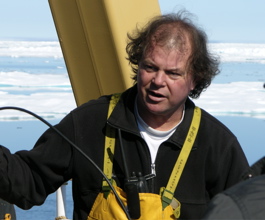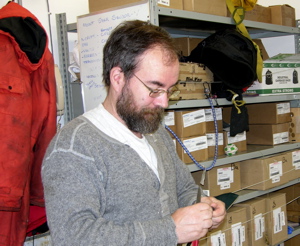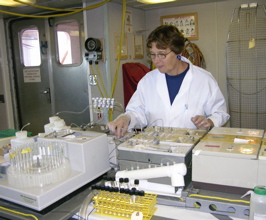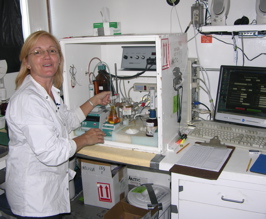Luc RainvilleJuly 31, 2007
Probably the most important tool for any oceanographic expedition is the CTD rosette. I am sure I've already mentioned it, and it will come back over and over. "CTD" stands for Conductivity, Temperature, and Depth, the three main variables we measure - although technically we measure pressure, not depth. From these we can calculate the salinity and density as functions of depth (vertical profile). Along with this set of sensors, the frame (the "rosette") has several other instruments attached to it to measure the amount of light, fluorescence, oxygen, the turbidity, etc. Different scientists on board are interested in different variables. We measure all these from the surface to the bottom of the ocean, which can be about 4000 am in the Beaufort Sea. Well... not quite the bottom of course. We try to get close to it (5m). The last thing we want is to bring back a rosette covered in mud with broken sensors. The rosette also has a set of large bottles (24 10-liter bottles) to collect water from various depths. We open the bottles before the cast, go down, and close the bottles on the way back up at various interesting depths. The water samples can then be analyzed to measure a whole other set of chemical and biological variables. People on board are doing a variety of analyses, which I will talk about in future dispatches. Mike Dempsey and Hugh Maclean, both from IOS, are primarily responsible for the deployment of the CTD. They each have 3 other scientists helping them deploy and recover the rosette (along with the ship deckhands operating the winch), and collect the water samples. During this cruise we will be doing a lot of CTD casts, which can happen at anytime during the day or the night (although there is always daylight...), so they divided the team in 2 watches, from 12 to 12 (noon to midnight or midnight to noon). So no matter what time it is, there is always a bunch of scientists awake, ready to deply instruments (several are awake at odd hours anyway, taking care of some measurement or analysis). Many of the water samples can (and need to) be analyzed directly on the ship. The IOS team also includes Linda White, performing the nutrient analysis, and Mary Steel, analyzing the oxygen samples. They can been seen all day running around the lab, preparing samples and playing with fancy instruments.
Last updated: October 7, 2019 | ||||||||||||||||||||||||
Copyright ©2007 Woods Hole Oceanographic Institution, All Rights Reserved, Privacy Policy. | ||||||||||||||||||||||||


